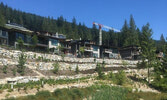British Pacific Properties Awarded Innovation Points for Water Conservation
Passionate builders are looking for ways to keep their projects smart and sustainable—we love that. In an effort to encourage and reward better building technologies and innovations above and beyond what’s contained in our programs, we’ve added “innovation points” to our programs.
British Pacific Properties has long been a prominent member of the development sector—and of Built Green Canada. They’re also the first to submit a proposal for innovation points; their worthy submission focused on water conservation is currently under review with our Technical Standards Committee.
For over 85 years, British Pacific Properties has been artfully designing and developing land in West Vancouver including the British Properties, the Capilano Golf and Country Club, the iconic Lions Gate Bridge, Park Royal Shopping Centre, Whitby Estates, and the Rodgers Creek residential community. Building luxury custom homes for over 20 years, Mulgrave Park is one of their latest neighbourhoods under development.
Mike Parker, Senior Project Manager from British Pacific Properties says they approach each project as “land custodians with a view it is their responsibility to protect it.” A good thing too, as Mulgrave Park is surrounded by over ten acres of dedicated parkland and protected green space. This forested mountainside looks out over the ocean, on a picturesque but formidable building site.
The annual rainfall on these mountain slopes of metro-Vancouver’s North Shore is one third greater than in the rainiest city in Canada: Abbotsford, British Columbia. This location poses a number of challenges, not least how to manage that much runoff with minimal disruption to the natural oasis it’s built on: they’re dealing with water onsite and water offsite.
As land is developed, it’s important to facilitate on-site water infiltration—allowing rainwater to flow back into the ground, rather than into storm sewers, which would both increase the demand on infrastructure and further disrupt the natural environment. Meanwhile, exfiltration pits capture storm water run-off from the roads and hard surfaces, screening out pollutants, and filtering the water before it’s returned to the soil.
Building on a site with this level of rainfall—and the resulting runoff from the mountain slope rising 750 meters above the site—British Pacific Properties has a lot of water to direct from its hardscape surfaces. And yet, their consulting team, on this project led by John Tynan of Webster Engineering, managed to do it: infiltrating or conveying rainwater and groundwater from each building site into natural drainage paths throughout the development.
How? Each lot integrates rain barrels and absorbent soils, with an extensive natural landscaping program to reduce runoff. Driveways and patios are made with permeable brick paver systems. Their design guides excess water through an exfiltration trench, then into both a nearby detention pond and wetland that allows for absorption into the surrounding soil, then finally the reduced and filtered water makes its way to the natural drainage channels around the development. Meanwhile, in their efforts to protect the land, British Pacific Properties has retained over 55 per cent of the development area as protected park land, which further aids in absorbing water and preventing soil erosion.
British Pacific Properties’ approach to reduce the environmental footprint of this challenging development and keep water re-integration on-site informed their “innovation points” submission to Built Green Canada. Their work is being recognized, and Built Green’s first innovation points for the Mulgrave Park project have been awarded. These submissions contribute to establishing special rulings on unique situations, such as this one, and when appropriate, help to inform new checklist items (opportunities to earn points toward home certification) that will appear on a future checklist.
As a critical natural resource under threat, Water Conservation is one of the seven sections of the BUILT GREEN® program, and is an essential part of the holistic approach to sustainable building. And so, the filtration methods demonstrated on this project are the sorts of practices Built Green Canada rewards. The remaining six sections are Energy and Envelope, Materials and Methods, Indoor Air Quality, Ventilation, Waste Management, and Business Practices.
Point requirements per checklist section are required for home certification, and there are plenty of checklist items to choose from, supporting the builder’s ability to customize their build based on the goals, budget, customers, and project location—while ensuring all seven categories have been taken into account. Parker says that the program’s flexibility and convenient point systems make Built Green particularly appealing for them, with minimal fees affecting their bottom line.
The company’s long history in the industry has allowed them to watch how it’s changed. Over time, British Pacific Properties has adapted to changing community needs and has transitioned from a developer of single-family lots to a builder of a range of housing options from luxury single-family to ground-oriented townhomes to concrete apartment condominiums. Now British Pacific Properties controls the development process from start to finish and regulates the development of complete communities through thoughtful and sustainable planning, servicing, design, and construction.
Today there’s greater density and infrastructure to work around, and developments are in tighter pockets of land, but their concerns around controls remain. The voluntary third-party certification of these projects only adds to their credibility and their ability to prove the good work they’re doing; their Mulgrave Park single family houses and apartments are being certified at BUILT GREEN® Silver, Gold, and Platinum level.
Parker says that their staff is proud of the company’s efforts to sustainably developing land. They’ve also learned that when they bring in sub-trades early and outline their vision and performance goals, the process is not only rewarding but straightforward.
Mulgrave Park is scheduled for completion in 2020.

